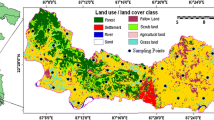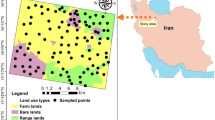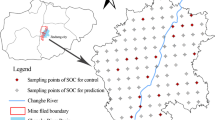Abstract
Soil organic carbon has favorable effects on the chemical, physical and thermal properties of soil, as well as its biological activities. Organic matter carbon is one of the important elements in soil, which plays a crucial role in soil quality of the forest ecosystems. In this research, to exactly estimate carbon sequestration (CS) according to the organic carbon and bulk density, we used RBF, MLP and multiple regression models. To do so, we took 60 soil samples from the depth of 0–15 cm of soil, across an altitudinal gradient of the forest, located at the Tarbiat Modares University Training Forest, and physicochemical soil properties (i.e., nitrogen, calcium, potassium, clay, silt, sand, organic carbon, pH, EC, bulk density and soil water content) as input variables for prediction of CS were measured. The results showed that CS of the study region was affected by soil physical and chemical characteristics. Furthermore, in all states, the RBF model statistically proved to have better prediction of CS compared to the MLP neural network and regression analysis, where the highest correlation between input variables and CS predicted with the least error was evident for RBF model followed by MLP and regression analysis, respectively. Moreover, the rate of carbon sequestration was not significantly affected by the amount of silt, whereas soil water content and soil electrical conductivity slightly affected the CS rate.









Similar content being viewed by others
References
Aitkenhead MJ, Donnelly D, Sutherland L, Miller DG, Coull MC, Black HIJ (2015) Predicting Scottish topsoil organic matter content from colour and environmental factors. Eur J Soil Sci 66(1):112–120
Allison LE (1975) Organic carbon. In: Black CA, Evans DD, White JL, Ensminger LE, Clark FE (eds) Methods of soil analysis, part 2, chemical and microbiological properties. American Society of Agronomy, Madison, p 1367
Amato M, Ladd JN (1992) Decomposition of C14 labeled glucose and legume material in soils: properties influencing the accumulation of organic residue C and microbial biomass C. Soil Biol Biochem 24:455–464
Ataeean PAM, Sepehr PI (2018) Estimation of soil organic carbon using artificial neural network models and multiple linear regressions based on color processing. Agric Mach 8(1):137–148
Bennett L (2017) Deforestation and climate change. The Climate Institute, Washington, DC
Bispo A, Andersen L, Angers DA, Bernoux M, Brossard M, Cécillon L, Comans RN, Harmsen J, Jonassen K, Lamé F, Lhuillery C (2017) Accounting for carbon stocks in soils and measuring GHGs emission fluxes from soils: do we have the necessary standards? Front Environ Sci 5(41):1–12
Broeke J, Pérez JMM, Pascau J (2015) Image processing with Image J. Packt Publishing Ltd, Birmingham
Bouyoucos GJ (1962) Hydrometer method improved for making particle size analysis of soils. Agron J 56:464–465
Bower CA, Reitemeier RF, Fireman M (1952) Exchangeable cation analysis of saline and alkali soils. Soil Sci 73:251–261
Canadell JG, Raupach MR (2008) Managing forests for climate change mitigation. Science 320(5882):1456–1457
Caudill M (1987) Neural networks primer: part I. AI Expert 2:46–52
Chai T, Draxler RR (2014) Root mean square error (RMSE) or mean absolute error (MAE)? Arguments against avoiding RMSE in the literature. Geosci Model Dev 7:1247–1250
Dercova K, Sejakova Z, Skokanova M, Barancikova G, Makovnýkova J (2006) Potential use of organomineral complex (OMC) for bioremediation of Penta chlorophenol (PCP) in soil. Int Biodeter Biodegr 58(3–4):248–253
Emamgholizadeh S, Esmaeilbeiki F, Mohammadi B, Zarehaghi D, Marofpoor I, Rezaei H (2018) Estimation of the organic carbon content by the pattern recognition method. Commun Soil Sci Plant Anal 49(17):2143–2154
Fernandes RBA, De Carvalho Junior IA, Ribeiro Junior ES, Mendonça EDS (2015) Comparison of different methods for the determination of total organic carbon and humic substances in Brazilian soils. Rev Ceres 62(5):496–501
Handayani IP, Coyne MS, Barton C, Workman S (2008) Soil carbon pools and aggregation following land restoration: Bernheim Forest. Kentucky J Environ Monit Restor 4:11–28
Hassink J, Whitmore AP (1997) A model for the physical protection of organic matter in soils. Soil Sci Soc Am J 61:131–139
Hecht R (1987) Kolmogorov mapping, neural network existence theorem. In: 1st IEEE ICNN, vol 3, San Diego
Koch Y (2012) Variability of soil properties in relation to uprooted, and the tree in a forest canopy gaps Amikhteh rash hirkani, PhD thesis forestry, Tarbiat Modares University, p 157
Lal R (2014) Soil carbon management and climate change. In: Hartemink AE, McSweeney K (eds) Soil carbon. Progress in soil science. Springer, Berlin, pp 339–361
Minasny B, Malone BP, McBratney AB, Angers DA, Arrouays D, Chambers A, Chaplot V, Chen ZS, Cheng K, Das BS, Field DJ (2017) Soil carbon 4 per mille. Geoderma 292:59–86
Muller T, Hoper H (2004) Soil organic matter turnover as a function of the soil clay content: consequences for model applications. Soil Biol Biochem 36:877–888
Plaster E (1985) No Title Soil science and management. Delmar Publishers Inc., Albany, NY
Somaratne S, Seneviratne G, Coomaraswamy U (2005) Prediction of soil organic carbon across different land-use patterns: a neural network approach. Soil Sci Soc Am J 69:1580–158
Spaccini R, Mbagwu JC, Igwe CA, Conte P, Piccolo A (2004) Carbohydrate and aggregation in lowland soil of Nigeria as influenced by organic input. Soil Till Res 75:161–172
Wang B, Xue S, Liu GB, Zhang GH, Li G, Ren ZP (2012) Changes in soil nutrient and enzyme activities under different vegetation are in the Loess Plateau area, Northwest China. Catena 92:186–195
Acknowledgements
The authors greatly appreciate the University of Tarbiat Modares for its helpful feedback.
Author information
Authors and Affiliations
Corresponding author
Additional information
Editorial responsibility: M. Abbaspour.
Rights and permissions
About this article
Cite this article
Cheshmberah, F., Fathizad, H., Parad, G.A. et al. Comparison of RBF and MLP neural network performance and regression analysis to estimate carbon sequestration. Int. J. Environ. Sci. Technol. 17, 3891–3900 (2020). https://doi.org/10.1007/s13762-020-02696-y
Received:
Revised:
Accepted:
Published:
Issue Date:
DOI: https://doi.org/10.1007/s13762-020-02696-y




